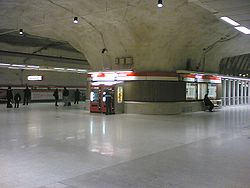
Civil defense in Finland
Encyclopedia

War
War is a state of organized, armed, and often prolonged conflict carried on between states, nations, or other parties typified by extreme aggression, social disruption, and usually high mortality. War should be understood as an actual, intentional and widespread armed conflict between political...
time as well as in peace
Peace
Peace is a state of harmony characterized by the lack of violent conflict. Commonly understood as the absence of hostility, peace also suggests the existence of healthy or newly healed interpersonal or international relationships, prosperity in matters of social or economic welfare, the...
time. The act stipulated that the ministry was to be responsible for providing shelters
Air-raid shelter
Air-raid shelters, also known as bomb shelters, are structures for the protection of the civil population as well as military personnel against enemy attacks from the air...
in high-risk areas, for evacuating
Emergency evacuation
Emergency evacuation is the immediate and rapid movement of people away from the threat or actual occurrence of a hazard. Examples range from the small scale evacuation of a building due to a bomb threat or fire to the large scale evacuation of a district because of a flood, bombardment or...
civilian population from threatened areas, and for limiting damage from natural disaster
Natural disaster
A natural disaster is the effect of a natural hazard . It leads to financial, environmental or human losses...
s. In emergency situations, firefighting, rescue
Rescue
Rescue refers to responsive operations that usually involve the saving of life, or prevention of injury during an incident or dangerous situation....
, ambulance
Ambulance
An ambulance is a vehicle for transportation of sick or injured people to, from or between places of treatment for an illness or injury, and in some instances will also provide out of hospital medical care to the patient...
, and first-aid services are coordinated with the civil defense effort. Civil defense operations are entirely a civilian responsibility.
The ministry delegated the implementation of national policy to county and municipal authorities, which acted through locally appointed civil defense boards. These boards supervised operations from more than 100 civil defense centers designated throughout the country. Personnel in national and local government agencies, committed to civil defense in emergency situations, and in independent voluntary organizations that would come under their jurisdiction numbered over 100,000. Nongovernment organizations involved in civil defense activities include the Finnish Red Cross
Finnish Red Cross
The Finnish Red Cross is a part of International Federation of Red Cross, which is one of the biggest and well-known international organisation in the world and on the field of humanitarian aid. FRC has over 90,000 members and around 45,000 active volunteers in Finland. FRC is divided to 12...
and the Rescue Service. Police
Law enforcement in Finland
Law enforcement in Finland falls under the jurisdiction of the Finnish Police, a national police agency.The Finnish Police is divided into 24 local departments and three national agencies...
are also assigned to reinforce civil defense workers as conditions require.
An alarm system
Civil defense siren
A civil defense siren is a mechanical or electronic device for generating sound to...
is in place in urban centers to warn the civilian population of threatened attacks. During an emergency situation, instructions would be broadcast through normal media channels. The early warning civil defense system is tied into the nationwide military air surveillance system.

Helsinki
Helsinki is the capital and largest city in Finland. It is in the region of Uusimaa, located in southern Finland, on the shore of the Gulf of Finland, an arm of the Baltic Sea. The population of the city of Helsinki is , making it by far the most populous municipality in Finland. Helsinki is...
, 536,000 spaces were provided, of which 118,000 were in large rock shelters and 14,000 were in subway stations. The shelter space was sufficient to accommodate over 100 percent of the nighttime population of the city, but only 67 percent of the daytime population.
The most serious shortcoming of Finland's civil defense system is that 1.5 million Finns had no access to shelters. Another reason for concern is that many shelters are poorly equipped and maintained. All shelters are supposed to be outfitted with self-contained power and ventilation systems, sanitary facilities, and emergency supplies. Nevertheless, inspections during 1986 found that two-thirds of shelters in private buildings had some deficiencies.
Contingency plans include massive evacuation of civilians from likely target areas, threatened with attack by conventional forces in time of war. Medical services for civilian casualties would be provided at local facilities in coordination with the civil defense branch of the Ministry of Social Affairs and Health. In the 1980s civil defense authorities considered, however, that evacuation of the civilian population to escape fallout following a nuclear attack would be pointless, and no provision was made for such a contingency.
The public's perception of civil defense efforts was marked by considerable indifference during the 1980s. Although its system was far more complete than the systems in most countries of Western Europe
Western Europe
Western Europe is a loose term for the collection of countries in the western most region of the European continents, though this definition is context-dependent and carries cultural and political connotations. One definition describes Western Europe as a geographic entity—the region lying in the...
, Finland's annual expenditure per capita on civil defense of US$12 was well below the rate of other Scandinavian countries, which averaged US$20 per capita. The nuclear accident at Chernobyl in the Soviet Union in 1986 underscored Finland's vulnerability and triggered renewed concern over shortcomings in the civil defense program. In response, the government announced plans in 1988 to introduce an automatic radiation surveillance network to supplement the existing manual one and to ensure that an outdoor alarm system was operational in all municipalities. Now this network has been completed and is in operation.

